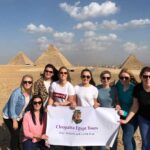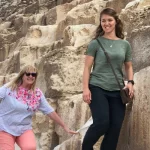Assiut Governorate:
In Pharaonic times Assiut was capital of the 13th nome (province) and center of the cult of Wepwawet, the wolf-headed god and avenger of Osiris. At the crossroads of caravan routes to the Western Desert oases and across the Sahara, the city has a long history as a center of trade. Until the mid-19th century, slaves who had survived the torturous “Forty Days Road” from Darfur in Sudan were sold here alongside camels in Egypt’s biggest slave market.
Today Assiut is the largest city in Upper Egypt and has the third largest university in the country. Known for its carpet making, Asyut remains the region’s main agricultural trading center.
The area is also associated with the Virgin Mary. In August 2000, the Virgin was reportedly seen above St Mark’s Church. For a few months afterward, there were reports of lights around the church towers and many thousands flocked to see them. The apparitions have now ceased.
Environs
Coptic Christians believe that Mary, Joseph and the baby Jesus sheltered in caves at Dirunka, 12 km (7 miles) southwest of Asyut. They were escaping from King Herod, who had ordered the killing of all baby boys under the age of two in Bethlehem.
A large convent, the Convent of the Holy Virgin, was built nearby. During the annual Moulid of the Virgin, held between 7 and 22 August, around 50,000 pilgrims flock here to see icons paraded around the cave-church.
Another place held sacred by Christian Copts is the Burnt Monastery (Deir al-Muharraq). This is situated on the edge of the desert, 5 km (3 miles) outside Al-Qusiya, a small town 42 km (26 miles) north of Asyut.
The Holy Family is said to have lived in a cave here for a month and it is thought that the church built over it was the first in Egypt.
What is now the church’s altar stone once blocked the entrance to the cave. The annual moulid, which is held here between 21 and 28 June, attracts many thousands of visitors.
A further 7 km (4 miles) west of the monastery is the Tombs of Mir, a burial ground dating from the Old and Middle Kingdoms.
Book your Travel Package now to know more about Egypt history.





